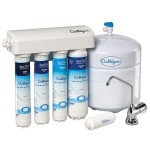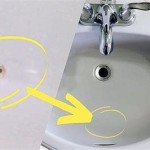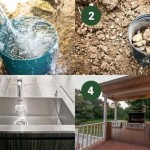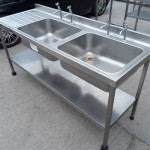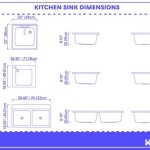P Trap For Bathroom Sink
A P-trap is a plumbing fixture that is installed under a sink to prevent sewer gases from entering the home. It is a J-shaped pipe that traps water, creating a barrier between the drain and the sewer line. The water seal in the P-trap prevents gases from escaping, while still allowing water to flow through the drain.
P-traps are typically made of plastic or metal, and they come in a variety of sizes and shapes to fit different sinks. The size of the P-trap is determined by the diameter of the drain pipe. The shape of the P-trap is determined by the space available under the sink.
To install a P-trap, you will need a wrench, a screwdriver, and a putty knife. First, remove the old P-trap by loosening the nuts that hold it in place. Then, clean the drain pipe and the underside of the sink with a putty knife. Apply a bead of plumber's putty to the drain pipe, and then install the new P-trap. Tighten the nuts to secure the P-trap in place.
It is important to keep the P-trap clean to prevent clogs. Clogs can cause water to back up into the sink, and they can also lead to sewer gas leaks. To clean the P-trap, remove the nuts that hold it in place, and then pour a cup of vinegar down the drain. Allow the vinegar to sit in the P-trap for several hours, and then flush the drain with hot water.
P-traps are an important part of any plumbing system. They help to prevent sewer gases from entering the home, and they also help to keep drains clear. By following these simple tips, you can keep your P-trap clean and working properly.
Types of P-traps
There are two main types of P-traps: slip joint P-traps and compression P-traps. Slip joint P-traps are the most common type of P-trap. They are made up of two pipes that are connected by a slip joint. The slip joint allows the pipes to be adjusted to fit different sink sizes. Compression P-traps are made up of two pipes that are connected by a compression nut. The compression nut is tightened to secure the pipes in place.
Slip joint P-traps are easier to install than compression P-traps. However, compression P-traps are more secure and less likely to leak. The type of P-trap that you choose will depend on your needs and preferences.
Materials
P-traps are typically made of plastic or metal. Plastic P-traps are lightweight and easy to install. However, they are not as strong as metal P-traps. Metal P-traps are more durable and long-lasting. However, they are also more expensive than plastic P-traps.
The type of material that you choose for your P-trap will depend on your needs and budget. If you are looking for a lightweight and easy-to-install P-trap, then a plastic P-trap is a good option. If you are looking for a durable and long-lasting P-trap, then a metal P-trap is a better choice.
Size
The size of the P-trap that you need will depend on the diameter of the drain pipe. The most common size for a P-trap is 1-1/2 inches. However, you may need a larger or smaller P-trap depending on the size of your drain pipe.
It is important to choose the right size P-trap for your sink. If the P-trap is too small, it will not be able to trap water effectively. If the P-trap is too large, it will take up too much space under the sink.
Installation
Installing a P-trap is a relatively simple process. However, it is important to follow the instructions carefully to avoid leaks. To install a P-trap, you will need a wrench, a screwdriver, and a putty knife.
- First, remove the old P-trap by loosening the nuts that hold it in place.
- Next, clean the drain pipe and the underside of the sink with a putty knife.
- Apply a bead of plumber's putty to the drain pipe, and then install the new P-trap.
- Tighten the nuts to secure the P-trap in place.
Once the P-trap is installed, you can test it for leaks by running water into the sink. If there are any leaks, tighten the nuts until the leaks stop.
Maintenance
P-traps require very little maintenance. However, it is important to keep them clean to prevent clogs. Clogs can cause water to back up into the sink, and they can also lead to sewer gas leaks.
To clean the P-trap, remove the nuts that hold it in place, and then pour a cup of vinegar down the drain. Allow the vinegar to sit in the P-trap for several hours, and then flush the drain with hot water.
By following these simple tips, you can keep your P-trap clean and working properly.

Simple Drain 1 25 In Rubber Threaded P Trap Bathroom Single Sink Kit 3ea 1v2 Tc0 The Home

How To Install The P Trap Under A Sink Dummies

Reviews For Simple Drain 1 25 In Rubber Threaded P Trap Bathroom Single Sink Kit Pg 3 The Home

How To Install P Trap And Bathroom Sink Drain Piping Easy Installation For Beginners Youtube

Bathroom Sink Plumbing Installation Diy Montreal

Simple Drain P Trap Bathroom Single Sink Kit 1 25 Rubber Threaded Camping World

Snappytrap Snappy Trap Universal Drain Kit For Bathroom Sinks Black Adapts To 1 4 In 2 Sink Drains And Wall Pipes The Under Plumbing Department At Com

Bathroom Sink Plumbing Installation Diy Montreal

What Is A P Trap With Pictures Under Bathroom Sink Drain

Anti Odor Insects With Flexible P Trap Bathroom Sink Drain Pipe Mutoosanitary
